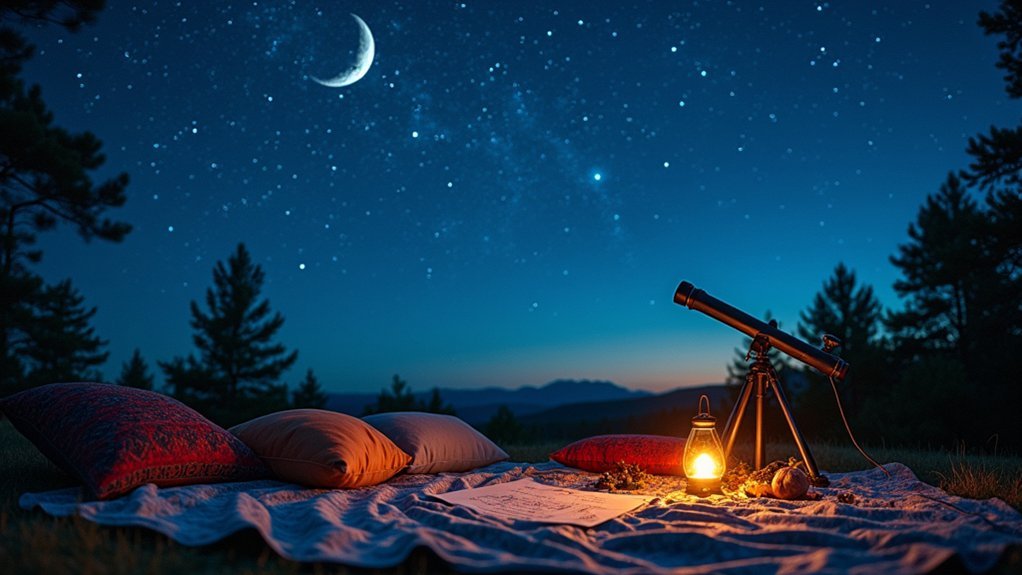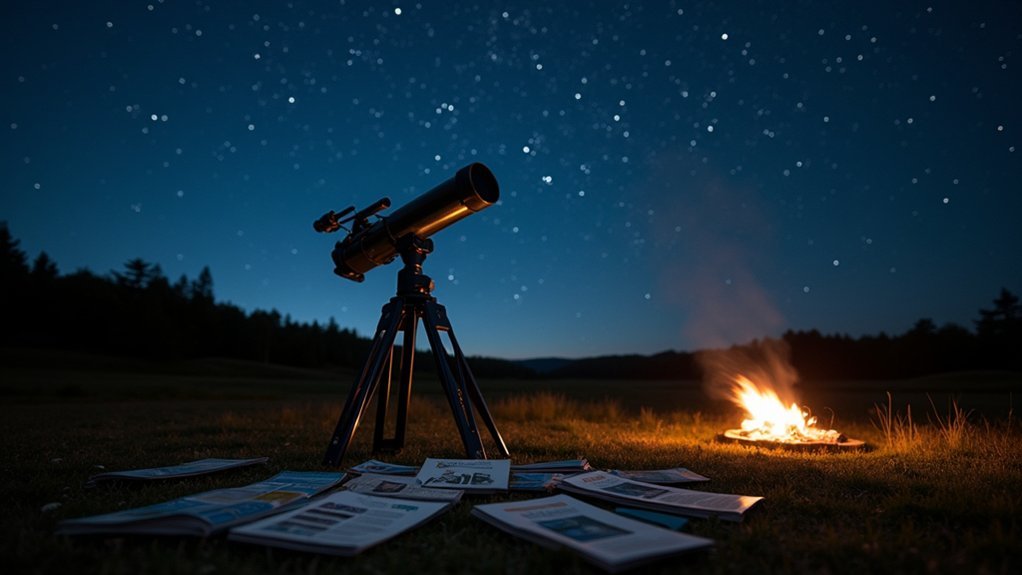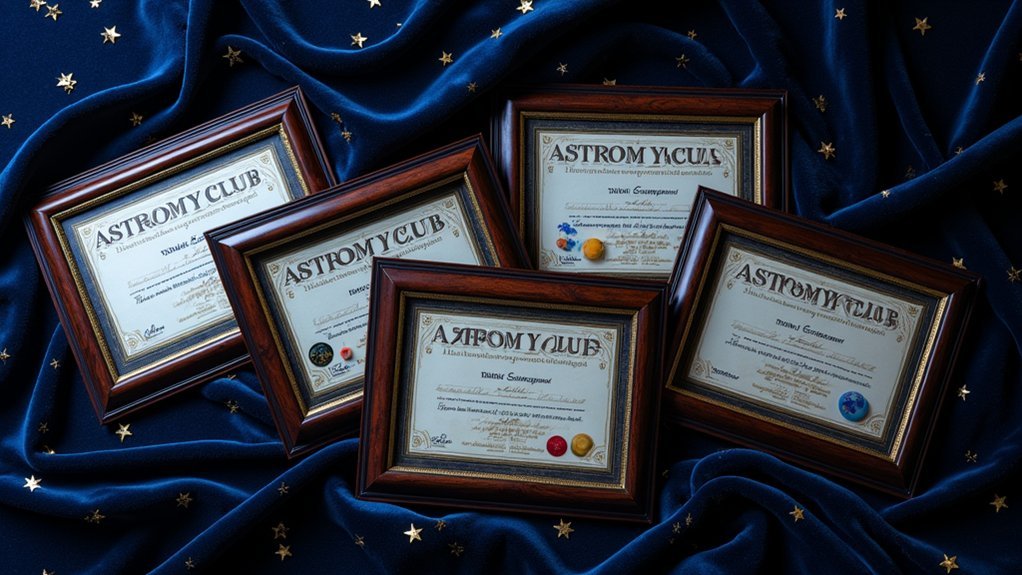Astrophotography transforms your relationship with the night sky, revealing cosmic wonders invisible to the naked eye. You’ll capture breathtaking images of stars, galaxies, and nebulae while developing technical photography skills. With just a DSLR camera, tripod, and wide-angle lens, you can begin this rewarding journey that combines art with science. The thrill of capturing your first successful Milky Way shot or distant galaxy will inspire you to explore ever deeper into the universe’s mysteries.
The Magic of Capturing the Cosmos

When you point your camera toward the night sky, you’re not just taking a photograph—you’re capturing the infinite tapestry of the cosmos. This simple act connects you to the universe in a profound way, revealing details your eyes alone can’t perceive.
With just a basic DSLR camera and tripod, you’ll gain the ability to capture the Milky Way in all its splendor. The swirls of distant galaxies and streaks of meteor showers become your artistic canvas.
The cosmos awaits your lens—where distant stars transform into personal masterpieces under your patient gaze.
Astrophotography invites you to seek out dark skies, far from city lights, where stars multiply exponentially. In these quiet moments of waiting and watching, you’ll develop both technical skills and patience.
The first time you successfully photograph celestial objects, you’ll experience a unique thrill that keeps enthusiasts coming back night after night.
Essential Equipment for Your First Night Sky Shoot
Three key pieces of equipment form the foundation of any successful astrophotography session.
First, invest in a sturdy tripod that prevents camera shake during long exposures, ensuring sharp images of celestial objects.
Second, a DSLR or mirrorless camera with wide aperture capabilities (f/1.4-f/4) will capture more light in dark conditions. Choose shorter focal lengths (14-24mm for full-frame or 10-18mm for crop sensors) to frame the night sky effectively.
To minimize vibrations further, use a remote shutter release or your camera’s delay timer when shooting.
Apps like PhotoPills help plan your shoot by tracking celestial movements.
Don’t forget practical accessories like a headlamp with red filter to preserve your night vision while working in dark areas with minimal light pollution.
Understanding Camera Settings for Stellar Images

Capturing the cosmos requires you to master the exposure triangle of aperture, ISO, and shutter speed through your camera’s manual mode.
You’ll need to set a wide aperture (f/2.8 or wider), balance ISO between 1600-6400, and calculate shutter speed using the 500-rule to prevent star trails.
Proper manual focusing on a bright star through Live View guarantees your celestial subjects appear as crisp points of light rather than fuzzy blobs in your final image.
Mastering Exposure Triangles
Although photographing the night sky might seem intimidating at first, understanding the exposure triangle will transform your ability to capture stunning celestial images. This critical relationship between aperture, shutter speed, and ISO setting controls how your camera captures light from distant stars and galaxies.
Start with a wide aperture (f/1.4 to f/4) to gather maximum light, then calculate your shutter speed using the 500 rule to prevent star trails. Your ISO setting should balance sensitivity and noise, typically between 800-6400.
For best results:
- Use your camera’s histogram to verify images are properly exposed
- Adjust your aperture as wide as possible while maintaining sharpness
- Find your ISO sweet spot where you capture enough light without excessive noise
Focus Techniques Matter
With the exposure triangle mastered, your next challenge is achieving tack-sharp focus on celestial objects millions of light-years away.
Switch to manual focus mode—autofocus simply won’t work in the dark. Rotate your focus ring to infinity, then dial it back slightly for ideal sharpness.
Use your camera’s Live View feature to magnify a bright star, adjusting the focus ring until the star appears as a crisp point of light. This precision focusing technique is critical before starting any long exposures.
For your camera settings, begin with a wide aperture (f/2.8 or lower) to collect maximum light.
Calculate your shutter speed using the 500 rule, and start with ISO 1600-3200. Take test shots and make subtle adjustments until stars appear as sharp pinpoints against the night sky.
Finding the Perfect Dark Sky Location
Why does location matter so much for astrophotography? Simply put, light pollution is your biggest enemy when trying to capture celestial objects. To find ideal dark sky locations, venture at least 20-30 miles away from urban areas where artificial lighting won’t interfere with your shots.
Light pollution destroys celestial detail. Escape the city glow to reveal the universe’s true splendor.
- Use specialized resources – Tools like Dark Site Finder and Light Pollution Map help identify areas with minimal light pollution.
- Consider elevation – High-altitude locations offer clearer skies with less atmospheric haze, resulting in sharper images.
- Check weather conditions – Monitor cloud coverage, atmospheric clarity, and moon phases before planning your shoot.
Don’t overlook seasonal variations—summer might reveal unique phenomena like noctilucent clouds that can add fascinating elements to your astrophotography compositions.
Mastering the Art of Focus in Complete Darkness

Once you’ve found your perfect dark sky location, achieving sharp focus becomes your next major challenge in astrophotography.
Switch to manual focus mode immediately, as autofocus rarely works when stars are your primary subjects. Use your camera’s Live View function to locate bright stars, then magnify the image to fine-tune your focus until stars appear as sharp points.
If your camera offers focus peaking, enable this feature to highlight in-focus areas, making precision adjustments easier.
Always take test shots after focusing, reviewing them carefully on your LCD screen to confirm star clarity. Make small adjustments and repeat as needed.
Remember to bring a flashlight with a red filter to preserve your night vision while adjusting settings—this simple tool makes a tremendous difference when working in complete darkness.
Planning Your Shoot Around Celestial Events
Because the night sky constantly changes throughout the year, successful astrophotography requires strategic planning around celestial events.
The dynamic canvas of our night sky demands photographers become strategic astronomers, planning each shot with celestial precision.
Use apps like PhotoPills to determine ideal shooting times for specific phenomena based on your location. Plan around new moons to maximize star visibility, or leverage a crescent moon to subtly illuminate your foreground without washing out the stars.
When planning your shoot, prioritize these three elements:
- Seasonal opportunities – Capture the Milky Way during May-June (rising) or September-October (setting)
- Lunar phases – Schedule shoots during new moons for darkest skies
- Weather forecasts – Monitor conditions closely, as clouds can ruin even the most meticulously planned celestial event
Remember that timing is everything—the difference between a mediocre and breathtaking image often comes down to preparation.
Wide-Field Astrophotography Techniques

Wide-field astrophotography represents your entry point into capturing the vastness of the night sky.
You’ll need a camera with a wide-angle lens (14-24mm for full-frame, 10-18mm for crop sensors) and a fast aperture of f/2.8 or wider to gather sufficient light.
Mount your camera on a sturdy tripod for long exposure shots ranging from 15-30 seconds. Adjust your camera settings with ISO between 1600-6400 to balance light collection and noise.
For best results, plan your shoots during a new moon when the sky is darkest and stars appear brightest.
Don’t neglect foreground compositions—incorporating landscapes or natural elements creates depth and context in your images.
Experiment with silhouettes against the starry backdrop to add visual interest while showcasing the majestic celestial scene above.
Deep-Sky Objects: From Nebulae to Galaxies
Venturing beyond the wide starry fields, deep-sky astrophotography opens a portal to the universe’s most breathtaking phenomena. With a tracking mount and some patience, you’ll capture celestial wonders invisible to the naked eye.
Start with beginner-friendly targets:
- Orion Nebula (M42) – Its brightness and intricate details make it perfect for practicing your skills with exposures as short as 30 seconds.
- Andromeda Galaxy (M31) – Visible even with small refractor telescopes, though you’ll need exposures of 3-5 minutes to reveal its spiral structure.
- Star clusters – These colorful collections provide excellent practice before tackling more challenging objects.
Image stacking is essential for deep-sky objects. Combining multiple exposures dramatically reduces noise while enhancing faint details that single shots miss, transforming good photos into spectacular ones.
Post-Processing Your Cosmic Captures

Post-processing transforms your celestial photos from dim, noisy captures into vibrant cosmic portraits by enhancing natural colors while reducing unwanted visual noise.
You’ll need to stack multiple exposures using software like DeepSkyStacker, combining light frames with calibration frames to dramatically improve your signal-to-noise ratio.
Once stacked, gentle stretching techniques will bring out nebulae details and galaxy structures without washing out star colors or creating artificial artifacts.
Enhancing Cosmic Colors
The vibrant purples of nebulae and golden hues of distant galaxies rarely appear in raw camera files as dramatically as they do in finished astrophotographs.
Post-processing is your secret weapon to transform dull, grayish images into spectacular cosmic portraits. By applying calibration frames during imaging, you’ll create a clean foundation to enhance colors later.
To elevate your cosmic palette:
- Stack multiple exposures to improve signal-to-noise ratio, revealing delicate details hidden in the noise
- Use software like Photoshop or Lightroom to adjust levels, curves, and saturation that bring out natural celestial colors
- Apply specialized plugins like AstroFlat Pro to combat light pollution and reveal the true colors of deep-sky objects
These techniques will help transform your initial captures into stunning visual representations of the universe.
Noise Reduction Techniques
Stellar astrophotography demands effective noise management to reveal the universe’s true beauty. You’ll need to master stacking exposures to improve your signal-to-noise ratio and minimize random sensor noise.
Calibration frames are essential for professional-quality results in post-processing:
| Frame Type | Purpose | When to Capture |
|---|---|---|
| Dark Frames | Reduces thermal noise | Same exposure/temperature as lights |
| Bias Frames | Corrects readout noise | Any time (camera settings consistent) |
| Flat Frames | Eliminates vignetting/dust | Same session as light frames |
| Light Frames | Your actual images | During ideal viewing conditions |
Use software like DeepSkyStacker to combine these frames for superior image quality. After stacking, gently stretch your histogram in Photoshop to reveal hidden details without overexposing bright stars. Plugins such as AstroFlat Pro can further enhance details and correct light pollution issues.
Stacking Multiple Frames
Now that you understand the various calibration frames, let’s examine how they work together in the stacking process. Stacking multiple frames dramatically improves your astrophotography by combining several short exposures to enhance signal-to-noise ratio.
When you capture approximately 200 individual 30-second Light Frames, along with Dark Frames, you’re setting yourself up for success.
Software like DeepSkyStacker handles the complex image processing by:
- Aligning your frames based on star positions
- Combining data to average out random noise
- Applying calibration frames to correct optical imperfections
After stacking, apply post-processing techniques such as gentle stretching in Photoshop to reveal faint details without overexposing bright stars.
This methodical approach transforms your raw cosmic captures into breathtaking celestial portraits that reveal details invisible in single exposures.
Common Mistakes and How to Avoid Them
Five critical mistakes can derail your astrophotography journey before it truly begins.
First, shooting in light-polluted areas ruins potential masterpieces—always use Light Pollution Map to find truly dark locations.
Light pollution is the silent killer of astrophotography—seek darkness to unveil the universe’s true splendor.
Second, neglecting proper camera settings leads to disappointing results; switch to Manual mode and carefully adjust ISO, aperture, and shutter speed for night conditions.
Third, you’ll waste hours if you can’t focus accurately on stars. Use Live View magnification and manual focus to achieve crisp images.
Fourth, many beginners overexpose their shots; opt for shorter exposures and check your histogram regularly.
Finally, skipping adequate planning almost guarantees frustration. Apps like PhotoPills help you predict celestial events and ideal shooting times.
With thoughtful preparation, you’ll avoid these common pitfalls and capture breathtaking night sky images.
Building Your Skills: From Basic to Advanced Techniques
Starting your astrophotography journey requires consistent practice with basic techniques before tackling complex methods.
Begin with mastering essential camera settings and capturing simple starry landscapes, which will build your foundation for future growth.
As you refine your skills through experimentation and learning, you’ll gradually progress from wide-field Milky Way shots to more advanced deep-sky imaging that once seemed impossible.
Practice Makes Perfect
In the domain of astrophotography, patience and persistence ultimately separate casual stargazers from skilled night sky photographers. Your camera and lens settings will rarely be perfect on the first try—you’ll need to experiment with various shutter speeds depending on whether you’re shooting during a full moon or in complete darkness.
Remember these essential practice principles:
- Document your progress – Track which settings worked best for different celestial subjects and light source conditions.
- Embrace trial and error – Each session provides invaluable insights on focus techniques and exposure adjustments.
- Join communities – Workshops and forums offer feedback that can dramatically accelerate your learning curve.
The path from capturing basic star trails to advanced deep-sky objects requires consistent practice.
Don’t get discouraged—even experienced astrophotographers continue learning with each shoot.
Start Small, Dream Big
While practice builds proficiency, having a structured approach to skill development will maximize your astrophotography progress. Your journey can begin with just a digital camera and tripod as you learn to shoot the night sky basics. This beginners guide encourages you to start small with achievable goals before tackling advanced techniques.
| Skill Level | Equipment | Target | Technique |
|---|---|---|---|
| Beginner | DSLR + tripod | Star trails, constellations | Long exposure |
| Intermediate | + remote trigger | Capture the Milky Way | Stacking images |
| Advanced | + star tracker | Nebulae, galaxies | Tracking mounts |
| Expert | + telescope | Deep sky objects | Guided imaging |
Set specific milestones like capturing the Andromeda galaxy or the Orion Nebula to maintain motivation. As you progress, you’ll naturally develop an eye for composition while mastering the technical aspects of astrophotography.
Master Settings First
Before capturing breathtaking cosmic images, you’ll need to understand your camera’s manual settings. Switch to Manual mode and experiment with wide apertures (f/2.8 or lower) to gather maximum light. Adjust ISO levels between 1600-6400, balancing sensitivity with noise.
Calculate proper shutter speed using apps like PhotoPills to prevent star trails while collecting enough light.
To master settings for astrophotography:
- Focus manually – Use Live View to zoom in on a bright star and adjust until it appears as a sharp point.
- Test and document – Take sample shots with different settings and record what works.
- Practice patience – Refine your technique by experimenting with various combinations of ISO, aperture, and exposure times.
Your astrophotography camera skills will improve with each session as you methodically document results.
Joining the Astrophotography Community
Initiating your astrophotography journey doesn’t have to be a solitary experience. The astrophotography community offers invaluable resources, support, and inspiration as you develop your skills. Engage through online forums and social media where experienced photographers share techniques and provide constructive feedback on your work.
Local astrophotography clubs create opportunities for hands-on learning and networking with fellow enthusiasts. Participating in star parties lets you practice alongside others while capturing celestial events in a collaborative environment.
| Community Type | Benefits | How to Join |
|---|---|---|
| Online Forums | 24/7 advice, global reach | Create accounts on specialized platforms |
| Local Clubs | In-person guidance, equipment sharing | Check astronomy centers, community boards |
| Social Media Groups | Quick feedback, trend awareness | Search hashtags, join Facebook groups |
| Star Parties | Live learning, shared experiences | Follow club calendars, observatory events |
Seasonal Opportunities for Night Sky Photography
When should you plan your astrophotography sessions throughout the year? Each season offers unique celestial subjects.
May and June provide prime Milky Way viewing as it rises dramatically, while September and October capture its setting after sunset.
Winter’s clear skies showcase Orion and other brilliant constellations during evening hours.
Moon phases greatly impact your shots—aim for new moons for maximum darkness or up to 30% visibility for natural foreground lighting.
- Summer highlights – Milky Way core visibility and ethereal noctilucent clouds
- Fall treasures – Setting Milky Way and earlier dark skies
- Winter opportunities – Crisp constellation views and December’s Geminid meteor shower
Don’t miss specific events like August’s Perseids, which offer spectacular chances to photograph meteor showers against the night canvas.
Frequently Asked Questions
How Do I Start Astrophotography for Beginners?
Start by getting a DSLR camera, tripod, and fast lens. Learn manual settings—high ISO, wide aperture, and appropriate shutter speed. Use planning apps, find dark locations, and experiment with composition. Join online communities for support.
What Are the Benefits of Astrophotography?
You’ll connect with the universe, improve your technical photography skills, and develop patience. It’s a chance to create stunning images and join a supportive community that fosters learning and artistic growth.
What Is the 500 Rule of Astrophotography?
The 500 Rule helps you calculate maximum exposure time to avoid star trails. Simply divide 500 by your lens’s focal length (in mm). For example, with a 24mm lens, you’d limit exposure to 20 seconds.
What Time Should I Start Astrophotography?
Begin during the new moon for darkest skies. Try May-June or September-October for Milky Way visibility. You’ll get best results between midnight and 3 AM when celestial objects are highest in the sky.
In Summary
You’re now equipped to commence on your astrophotography journey. Don’t worry about perfection—every cosmic capture teaches you something new. Start simple, be patient, and remember that this hobby rewards persistence. Join online communities, share your progress, and prepare to be amazed by what you’ll capture. The universe awaits your lens—all you need to do is look up and start shooting.





Leave a Reply